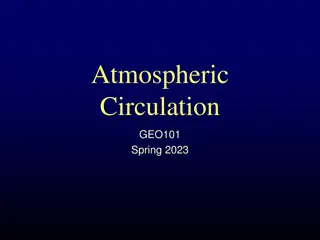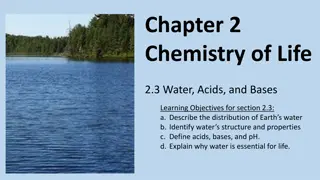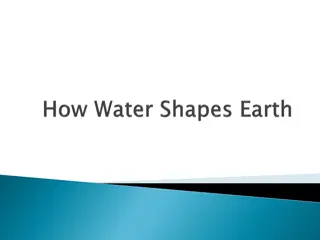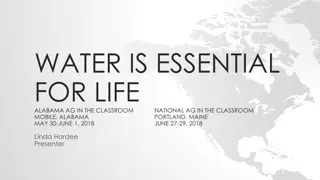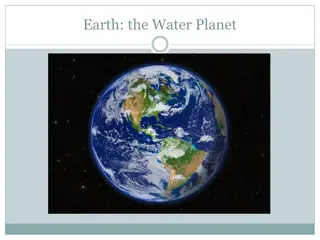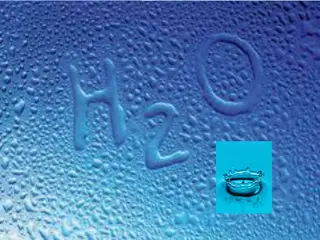Understanding Earth's Water Resources
Earth's water budget reveals that only a small fraction is fresh water, with a significant portion stored in ice caps and glaciers. Groundwater plays a vital role, housed in aquifers, where recharge and water table levels are crucial. Springs and surface water sources like rivers and lakes are essential for ecosystems. Lakes vary in formation and productivity levels. Overall, water resources are diverse and critical for life on Earth.
Download Presentation

Please find below an Image/Link to download the presentation.
The content on the website is provided AS IS for your information and personal use only. It may not be sold, licensed, or shared on other websites without obtaining consent from the author. Download presentation by click this link. If you encounter any issues during the download, it is possible that the publisher has removed the file from their server.
E N D
Presentation Transcript
Water Water Resources Resources
Earths Water Budget A small fraction of the earth s water is fresh water. ~2.6% Out of that - 80% is in the form of ice caps and glaciers. 0.6% is groundwater The rest is found in lakes, soil water and atmospheric water, rivers and biotic organisms.
Water Resources - groundwater Groundwater is all the water within the permeable and impermeable layers of rock and soil underneath the earth s surface layer. The areas where water is held underground is called an Aquifer. Two types of aquifers: 1. Unconfined aquifer porous rock covered by soil, where water can easily drain in and out to other aquifers. 2. Confined aquifers impermeable rock/clay layers where water is bound and not able to flow through to other aquifers. Groundwater recharge The area where water can percolate from above ground into the aquifer. If a confined aquifer is present the recharge area is where the impermeable rock has an opening at the surface. Water table the uppermost level at which water can fully saturate the rock or soil.
Water Resources When water naturally percolates up from an aquifer it is called a spring. Springs are very important to the ecosystem and the biotic organisms with an ecosystem. When a well is drawn from a confined aquifer, the pressure with the in aquifer is released. This is called an Artesian well. If the pressure is great enough, the pressure is able to bring water to the surface and no pump is needed to pull the water out. Most wells use a pump to change the pressure with in the aquifer and bring water to the surface. Water within a confined aquifer is deemed purer than unconfined aquifers. The reason for this is biotic contamination takes place much more frequently in unconfined aquifers, due to the closeness they have to the surface.
Water Resources Surface Water Includes: streams, rivers, ponds, lakes and wetlands. The three largest rivers in the world Amazon in South America. Congo in Africa Yangtze in China Early human settlements evolved around surface water. Reasoning is not just transportation but the fertile soil that is found near rivers, and lakes. The reason for the very fertile soil near surface water is that most rivers and lakes flood during spring when ice from the mountains melt and rain fall is heavier. This brings nutrient sediment from the lakes and rivers onto the land. 1. 2. 3.
Water resources - Lakes Lakes are produced in many ways. From dead volcanoes that leaves craters for water to collect in to glacial movement. Some of the most known Lake formations is from tectonic movement. Where land will rise and surround ocean water. This water is usually more high is saline. The Caspian Sea is one such lake. Lakes are classified into three groups by their primary productivity: Oligotrophic Low productivity due to low amounts of nutrients like phosphorous and nitrogen. 1. Mesotrophic moderate level of productivity. 2. Eutrophic High levels of productivity. 3. Wetlands and marshes are important to the ecosystem. During times of heavy rain or flooding, they absorb the excess water and store it. Wetlands are measured by surface area. Larges wetlands in the world is debatable but as of right now the Pantanal in South America is considered the largest while the Florida Everglades is 2ndlargest.
Water Resources - Atmospheric Smallest reservoir for water on Earth. And essential to global water distribution. Atmospheric water brings much needed nutrients like phosphorus and nitrogen to Earth s surface and soil fertility. The nutrient cycle (ie nitrogen cycle) is dependent on the water from the atmosphere. Arid regions rely on the atmospheric water to bring nutrients to the soil and for livelihoods of the people and other biotic life. With predictable rainy seasons. When a drought occurs because of a change in the atmospheric water, loss of soil fertility and death of biotic organisms is severe. Land becomes dry and the topmost soil where nutrients are found will blow away. (ie the dust bowl of West Texas and Southern Great Plains in the 1930 s)
Water Resources Human Impact Human over generations have increased in number, causing the settlement of new cities and a higher need for agriculture. Due to this need for expansion humans have started to develop on land once owned by nature. Some ways humans have altered the land through water is: Levees enlarged banks stopping the natural flooding of rivers and lakes that once brought nutrients to the surrounding soil. Dikes Built to stop ocean water from flooding coastal regions, especially in Europe where farmland is below sea level. Seen also in New Orleans where the city is below sea level. Dam Barrier that runs across a river or stream to control water flow. Water is usually stored on one side as a lake or Reservoir. Many purposes of a dam: for human consumption and entertainment, generate electricity and flood control (agricultural).
Water Resources Human Impact Aqueducts canals used to move water from one place to another. Man made instead of nature made. Seen since the Roman empire. Used to move water long distances. Like Northern California, Oregon to Southern California, for human consumption and agriculture. Desalination Some water poor countries are taking salt water and removing the salt from it to form fresh water that is able to be used for human consumption and agriculture. two most common ways: 1. distillation Boiling of the water so the evaporated water can be collected and the salt is left behind. 2. Reverse Osmosis water is forced through a thin semi- permeable membrane at high pressure. Water passes through the membrane but the salt particles are left behind.
Cont. Irrigation the use of water in agriculture. Four major types 1. Furrow Irrigation oldest practiced, easy and most inexpensive. Trenches are built along the crops and fills them with water, which then seeps through the ground into the soil. 2. Flood Irrigation Flooding the entire field with water and letting it soak in. 70 80% productive. 3. Spray Irrigation More expensive, involves a good amount of energy. Water is pumped from a well and then using a sprayer, sprays the field like a giant sprinkler system. 4. Drip Irrigation Water drips from hoses that have holes in them. This is done slowly and the hoses can be buried under the crops (95% effective) or above the soil.







